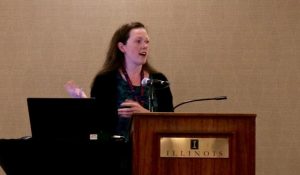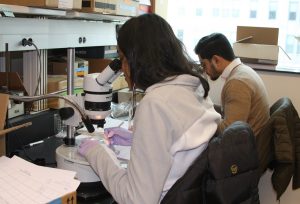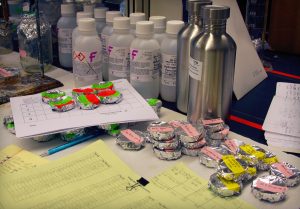June 26th, 2018 by Sarah Zack
Gillian Flippo is interning with Illinois-Indiana Sea Grant (IISG) as a recent graduate of Butler University with a bachelor’s degree in Science, Technology and Society.
I am a native of Chicago, and working for the health of my local environment and community is of great interest to me. As an intern for the IISG pollution prevention team led by Sarah Zack, I was fortunate to attend the 2018 Emerging Contaminants in the Aquatic Environment Conference (ECAEC), held June 5-6 in Champaign, IL. Newly developed chemicals and substances are used to improve processes and products; however, they often have unintended consequences on human and environmental health, which is why they are of emerging concern. Regardless of whether these contaminants are old or new, many brilliant minds are working to understand their effects, how they move through the ecosystem and how to properly prevent and remove them. At ECAEC, I witnessed these minds come together. Organized by the Illinois Sustainable Technology Center and Illinois-Indiana Sea Grant, the conference covered many important topics related to emerging contaminants over the course of two days.
A Widespread Problem
Keynote speaker Rainer Lohmann, a professor at the University of Rhode Island, studies the transport, fate and bioaccumulation of persistent contaminants. His findings demonstrated that these contaminants are not only found at the sites where they are being released. Through various methods such as the movement of water by ocean currents, the contaminants spread to some of the most remote places on earth.
These places that were once thought to be pristine, like the Arctic, are also feeling the effects of these potentially damaging chemicals. I learned that part of the reason these contaminants are found around the globe is because wastewater treatment plants aren’t designed to remove many pharmaceuticals and personal care products (PPCPs). Therefore, they are released into nearby streams and rivers, which eventually make it to the ocean.
Mitigation and Prevention

Alison Franklin, PhD student at Penn State, speaks at the 2018 Emerging Contaminants in the Aquatic Environment Conference.
Fortunately, there are scientists like Alison Franklin from Pennsylvania State University, who are researching ways to mitigate the emerging contaminants released from wastewater treatment plants. Her research demonstrates the possibility of using soil as a natural filter to improve water quality and protect human health, focusing on antibiotics in wastewater effluent. Her results showed that groundwater concentrations of antibiotics were lower than the wastewater effluent concentration after being filtered through soil. This suggests that soil may be an adequate third step in wastewater treatment. I found this interesting because the process uses part of nature as a partner to help combat environmental challenges like emerging contaminants.
A wide variety of professionals attended the ECAEC, providing a multi-disciplinary approach to solving the problem of emerging contaminants. Jill Bartolotta from Ohio Sea Grant offered an interesting perspective on the issue, focusing on single-use plastic and the underlying behavioral barriers that inhibit people from using reusables. Her study sought to tackle the problem from the source so that plastic is prevented from getting in waterways in the first place. One interesting piece that caught my attention was that Bartolotta’s survey results showed that people have enough reusable bags, but they forget to bring them to the store. Therefore, people don’t need more reusable bags but instead need new ways to be reminded to use them. This shows that we need to dig deeper to find a new approach to tackle the problem of single-use plastic.
Takeaways
Bartolotta’s talk especially captivated me because it was relevant to my interests in engaging the public on environmental issues. For PPCPs and other emerging contaminants like plastic, it is important to understand the real source of pollution: people and their practices. People may unknowingly pollute because they are simply unaware that what they are doing is wrong, which is why education is important. Or there may be behavioral barriers and incentives that lead people away from environmentally sustainable options, which is why understanding the underlying causes and thinking of alternative solutions are important.
It was incredibly eye-opening to see the research and effort that is being put into tackling the issue of emerging contaminants in the aquatic environment. It became obvious to me after listening to the conference speakers that this issue needs input from many disciplines for us to truly understand and solve the problem. Despite the size and complexity of the issue, it made me feel hopeful to know that it has the potential to be fixed. The conference was great to experience in the beginning of my internship because it helped me understand the work and research going into understanding the issue of emerging contaminants, while challenging me to think of effective ways to communicate the problems to the public.
May 2nd, 2018 by iisg_superadmin
University research projects often include an opportunity for a few students to get real-world field or laboratory experience. At Loyola University Chicago’s Micro Eco Lab, biologists Tim Hoellein and John Kelly have often found ways to connect students with their work. But when they set out to implement the lab’s recent Illinois-Indiana Sea Grant project, opportunities for students really took off.
To accomplish this ambitious, comprehensive study to assess microplastic levels in Lake Michigan waterways efficiently and timely, Hoellein and Kelly brought on a post doc to oversee the project. Rachel McNeish looked to students to get much of the work done and the pool of helpers grew to dozens—35 in all, including graduate, undergraduate, and high school students.

“Students were involved with fieldwork, sampling and processing,” said McNeish. They did all the lab work, including data curating—making sure it was entered correctly. Some students have been in charge of specific aspects of the process, making sure it is happening as it should. They then have an opportunity to take a portion of the dataset, analyze it, and present it on campus or at professional conferences.”
For Masters student Lisa Kim, her time spent working on microplastic research and outreach turned out to be life changing. She started her undergraduate tenure at Loyola as a pre-med student, but changed directions after her experience working on the Sea Grant project. “I really fell in love with lab work—getting samples and processing them, and then data analysis and even presenting the results on campus,” said Kim.
She is now an author on the first journal article from the IISG microplastic study, which thus far has found plastic microfibers in the water, sediment and fish in three main Lake Michigan rivers.
Kim is also working on her own research and is exploring opportunities to engage in outreach and in the policy process. “I really want to communicate information about microplastic pollution with everyone. I feel like I got experience working in the lab and doing research, but now I want to bridge the gap between scientists and the community.”
The students come from diverse backgrounds, including some who are first generation college students, and bring a range of interests and experiences. Many are new to the tasks at hand.
“My first time in the field was quite the challenge, balancing being in the canoe with sediment samples and other heavy equipment, all while trying to collect different types of samples from the water,” said Melissa Achettu, a Loyola junior.
Achettu, who has now been working on the IISG project for 18 months, has been funded by two Loyola fellowships to help with the study and to present findings at an international conference this spring.

With Loyola’s setting in Chicago, some students are also experiencing nature and camping for the first time. And with such a busy lab, they are developing leadership skills and learning to work together.
“I enjoy working in the lab with so many other students because it’s a great learning experience when people of so many backgrounds come together,” said Achettu. “Everyone has their unique inputs and ideas. We all learn patience, teamwork and communication skills.”
McNeish puts herself in that camp. “Undergraduate students have just been phenomenal the whole time I’ve been doing research and throughout my education,” she explained. “I feel like I can teach them many things, but they can also teach me a lot too. It’s a two-way learning system. And working with a large group, everyone has something to learn.”
As the research wraps up, McNeish herself is moving on to a new opportunity. She will start a tenure-track faculty position at California State University Bakersfield this August where, as a freshwater scientist, she plans to develop her own student-focused research program.
April 30th, 2018 by IISG
WEST LAFAYETTE, Ind. – Purdue University scientists led a comprehensive analysis of research concerning the effects of microplastics on aquatic life, with the results showing widely different impacts among different types of animals. Strong negative effects were particularly apparent for small animals, such as larval fish and zooplankton, a source of food for many species, suggesting serious potential consequences that could ripple throughout the food web.
Tomas Höök, an associate professor in Purdue University’s Department of Forestry and Natural Resources and director of the Illinois-Indiana Sea Grant College Program, led a team that designed a meta-analysis of research related to the effects of microplastics on aquatic life. The analysis, published in the journal Science of the Total Environment, used results from 43 other studies that each considered the effects of microplastics on consumption of food, growth, reproduction, and/or survival of aquatic animals. The analysis mathematically calculated one or more effect size(s) for each study, then those effects were combined statistically to understand the big-picture effect on animals. The animals included in this study were all aquatic but ranged from fish to mussels to sea urchins to worms.
The most significant findings included:
* Considering all effect sizes together, on average, exposure to microplastics negatively affects consumption, growth and survival of aquatic animals.
* However, the results are highly varied and not all groups of animals were affected in the same ways.
* Microplastics significantly reduced growth, reproduction and survival of zooplankton.
* When exposed to microplastics, larval and juvenile fish see negative effects on natural consumption of other foods.
“One of the types of organisms that seems to be affected is crustacean zooplankton, which are the main prey for many small fishes,” said Höök, whose findings were published in the journal Science of the Total Environment. “The fact that these very small organisms are consuming these microplastics, altering their growth, reproduction and survival, means there could be consequences up the food web. If zooplankton numbers decline, there may be less food available for organisms at higher trophic levels.”
Microplastics, small pieces of the material less than 5 millimeters in size, have been found in waters and soils in and around all seven continents. They come from a wide variety of sources, including broken-down food and drink containers, fibers from synthetic clothing, industrial waste and some beauty products.
Many organizations and governments have tried to reduce the amount of plastic pollution reaching water and wildlife, but the effects these microplastics are having on the range of aquatic life hasn’t been clear. Purdue’s meta-analysis puts all the current, applicable research into perspective.
“Our results most strongly support the notion that exposure to microplastics leads to negative effects on consumption of aquatic organisms, with less compelling and consistent evidence that growth, reproduction or survival of aquatic organisms is negatively affected by exposure to microplastics,” the authors find.
Carolyn Foley, a research associate in Purdue’s Department of Natural Resources and research coordinator for Illinois-Indiana Sea Grant, said few of the studies analyzed included microplastic fibers, the small pieces of plastic that break away from larger pieces. That might be an area to focus future research. She also suggested that while the effects on upper-level functions, such as reproduction and survival, were highly variable, there isn’t a similar summary of research examining how microplastics might be altering aquatic life in less perceptible ways.
“If microplastics aren’t having immediate effects on these upper-level functions, maybe there are less-obvious and cumulative negative impacts,” said Foley, who is the lead author of the paper. “It may be more important to look at finer-level effects, including molecular-level effects.”
The Illinois-Indiana Sea Grant College Program and Purdue’s Department of Forestry and Natural Resources funded the research.
A video of Tomas Höök discussing the effects of microplastics on aquatic life is available at https://www.youtube.com/embed/X6rd-MdAx3A?rel=0.
March 28th, 2018 by iisg_superadmin
As you dine on locally-caught fish, you probably aren’t thinking of that old acrylic sweater or fleece jacket that you wear and wash frequently. But it turns out that they may be on your plate. Illinois-Indiana Sea Grant-funded researchers have found microplastic fibers that come from clothing and other sources in the water, in sediment and in fish in three major rivers that flow into Lake Michigan.
Loyola University Chicago biologists John Kelly, Tim Hoellein and Rachel McNeish are assessing levels of microplastic using a range of measures. As part of a larger study, they collected samples from the mouths of the Muskegon, Milwaukee and St. Joseph rivers seasonally over the course of 2016 and into 2017.
“We found that 99 percent of the microplastic is fibers, and microfibers are everywhere,” said McNeish, a post doc who implemented the project. “Much of what we found is acrylic, polyester, and polyethylene, which comes from plastic bags.” These plastics break down to microscopic size in the water due to physical abrasion, sunlight and freezing.
While water sampling is typically done using nets, the Loyola team also sampled water directly. “We started doing these grab samples, we just fill up a liter container and bring it back and filter it, and we found particles smaller than 300 microns, the pore size of the nets,” said Kelly. “The smaller you go, the more numerous the pieces of plastic there are.”
The three rivers in this study have provided insight into the effect of how we use the land on how much microplastic is in the environment, which was a key goal of this project.
The most northern river, the Muskegon, which flows through land dominated by forests had less microplastic than the other two rivers, as one might expect. Moving south to more populated and developed areas, are the St. Joseph River, in a farm-rich watershed, and the Milwaukee River, which sits in a mixed, urban and agricultural region. The researchers found that both agriculture and urban land uses contribute significantly to the abundance of microplastic in these Lake Michigan tributaries.
“Ultimately what we really want to do is predict what aspects of our development or features of the landscape pose bigger problems when it comes to contributing microplastic to the landscape,” said Hoellein. “And we need to understand where microplastic accumulates the most, because if we don’t answer those questions, we’re not really in a good position to come up with a solution or even address the problem.”
The researchers also sampled 74 fish from the shallow waters of these three rivers and 85 percent of them, including bass and other sportfish, contained microplastic in their digestive tract, averaging 13 particles. They found that the amount of microplastic in individual fish was not a reflection of how much plastic was in the water—fish from all three sites had similar numbers of microfiber in their digestive system.
How much microplastic shows up in one fish versus another can better be explained by looking at the food web. The researchers found that fish that eat insects and other invertebrates, which may already contain microplastic, have more fibers than those that eat plants.
“Microplastic is interacting with aquatic wildlife,” said McNeish. “Fish are consuming it—either actively eating it thinking its food, eating insects with microplastic in them or maybe just drinking water with microplastic. Or they may consume it through contact with sediment. In any case, microplastic is entering the food web.”
“And as these three rivers drain into Lake Michigan,” she explained, “the movement of microplastic can happen with the rivers’ currents, but also through the migration of animals.”




